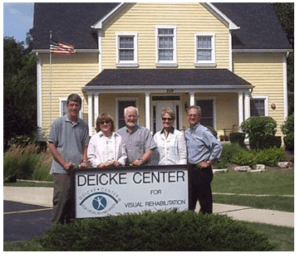
Kansas City, MO (August 10, 2007) — An historic event in low vision care was officially announced on August 10, 2007 at the third annual Envision 07 Conference in Kansas City, Missouri. As part of the keynote speech, R. Tracy Williams, O.D. described a model that has been developed over the past five months by leaders from optometry, ophthalmology, low vision, low vision rehabilitation and the low vision community, all of whom are dedicated to providing comprehensive low vision rehabilitation. The team was initially invited to the Henry Ford Visual Rehabilitation and Research Center in Detroit, Michigan on March 30-31, 2007 to address the issue, “What is the Optimum Low Vision Rehabilitation Delivery System?”
Lylas Mogk, M.D. represented the American Academy of Ophthalmology Vision Rehabilitation Committee (AAO VRC)
R. Tracy Williams, O.D. represented the American Optometric Association Low Vision Rehabilitation Section (AOA LVRS)
Mary Warren, O.T. represented the American Occupational Therapy Association (AOTA) Low Vision Certification Program
Jim Deremeik, CLVT represented the Association of Education and Rehabilitation of people who are Blind or Visually Impaired (AER)
Dan Roberts, Director of Macular Degeneration Support and the International MD Support Group, represented the consumer.
Two professional facilitators having no professional affiliation with the vision community conducted the meeting. The representatives participated on their own time and were reimbursed only for expenses incurred.
The objectives of the meeting were:
- Describe the essential qualities of an effective delivery system for low vision patients that ensures quality diagnosis and treatment for all who need it.
- Describe the collaboration between disciplines that is required to bring this system into being.
- Identify the steps that group participants will take to move this concept forward.
The initial meeting accomplished a draft “Consensus Low Vision Rehabilitation Delivery Model” along with general talking points describing the model diagram. It was agreed that all four professional representatives (AAO, AOA, AOTA and AER) would present the diagram and talking points to their respective association committee, council, program or related group for acceptance in concept.
A second meeting, held in Wheaton, Illinois at the Deicke Center for Visual Rehabilitation on July 13-14, 2007 provided the opportunity to further enhance the “Consensus Low Vision Rehabilitation Delivery Model” and talking points based on feedback from all participants. All four professional groups had previously accepted the draft, and the landmark collaborative “Low Vision Rehabilitation Delivery Model” was created.
The A-Team (as the study group was nicknamed) also realized the need to create a vehicle for an on-going collaboration among the four professional organizations to move forward with a common mission addressing the rehabilitation needs of the escalating population of low vision adults. In this spirit, it was decided that a third meeting should be planned to transition these ideas to other upcoming leaders in each profession along with an executive level representative from each discipline.
These meetings have demonstrated that the four professions can work together in the best interests of people with vision loss. The meetings have demonstrated a healthy level of respect, cooperation and sharing of resources to meet the current epidemic of people in America with vision loss. While this is only a small start on what can be done or needs to be done, the ultimate goal of the A-Team is a future embracing all groups, associations, agencies and people dedicated to helping those with vision loss.
Expenses for the A-Team meetings were supported by an unrestricted educational grant by LowVison.com and inspiration from Takashi Yamashita, CEO of Optelec US, Inc.